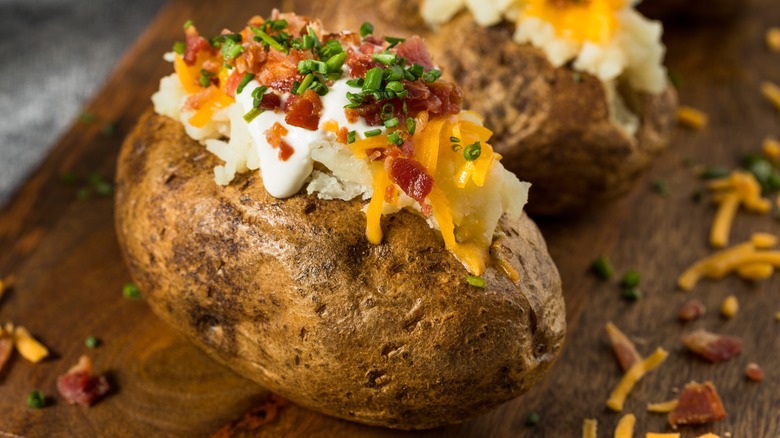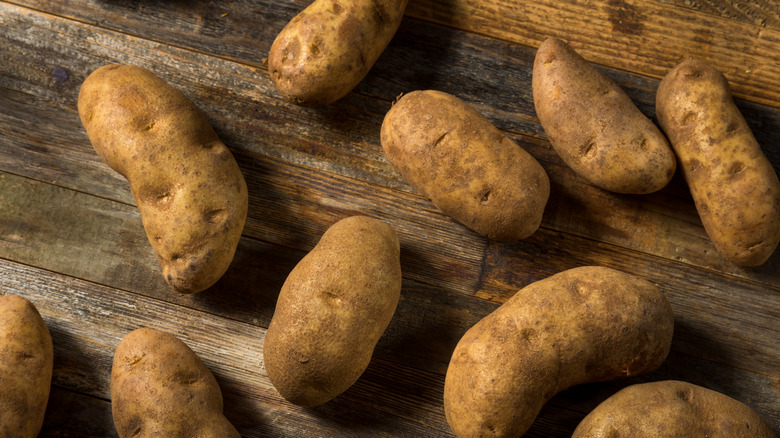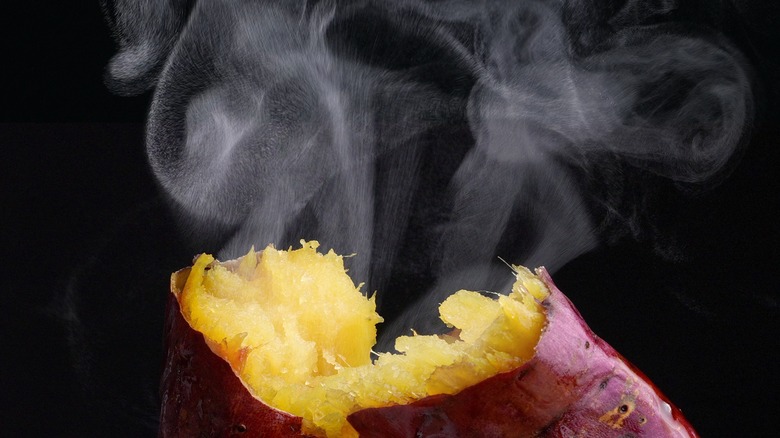The Common Mistake To Avoid For Evenly Cooked Baked Potatoes
Whether they're intended for a meal or a snack, baked potatoes are hard to beat. The texture profile — a crispy outer shell juxtaposed with soft and fluffy starches inside — is delightful. Plus, they can accommodate endless toppings, from classics like sour cream and bacon to more fancy fare like steak and mushrooms. If you're feeling adventurous, you can even stuff a baked potato with a hearty helping of tuna.
While the baking process is simple, there are still quite a few pitfalls preventing cooks from achieving spud perfection. At the top of this list is uneven cooking. If a potato is cooked unevenly, you can end up with a tuber that's golden on one side but scorched on the other. Even worse is a potato with a nice, crispy skin that isn't cooked all the way through. This annoying outcome usually happens when potatoes are cooked directly on a tray or sheet pan. To avoid this mistake, opt for using a rack the next time you pop a potato in the oven. Wire racks promote increased airflow, setting the stage for a nice, even bake.
Use a wire rack when baking potatoes
While it might seem harmless enough to toss a potato on a baking tray before going in the oven, this will result in an uneven bake. Convection ovens cook foods by engulfing them in a rotating pocket of extremely hot air. When a potato is lying on a pan, its top half will be exposed to hot air while its bottom half will be in contact with hot metal. This will result in each side cooking at a different rate, and your potato may develop an uneven finish. One side might be burned, while the other remains undercooked.
Instead of a tray, lay potatoes on a simple wire rack on top of a baking sheet. To promote even air exposure, make sure the potatoes aren't touching. If you don't have a wire rack handy, you can place potatoes directly on the oven rack itself. However, any oil and seasonings are liable to drip off the potatoes. In this case, place the potatoes on the top oven rack, followed by an empty sheet pan on the rack below. The lower pan will help catch drippings so you don't get a smokey mess accumulating at the bottom of your oven.
Other common baked potato mistakes
Besides uneven cooking, you might be making other mistakes when baking potatoes. Plenty of foods, especially large cuts of meat, have to rest after cooking. Potatoes aren't one of them. In an interview with the "Today" show, chef Isaac Toups recommends against any amount of rest: "This is not meat and the potato doesn't get better with resting. You need to cut it immediately to avoid a gummy and sticky consistency." To maintain fluffiness, you'll want to cut into the potato immediately after cooking.
It's essential to scrub your potatoes before placing them in the oven, but it's also important to dry them after washing. Any moisture on the potato surface will convert to steam in a hot oven. This steam will soften the potato's exterior, leading to a mushy skin instead of a crisp, crunchy finish. After washing, make sure to rub down your spuds with a towel and let them fully dry out before placing them in the oven.
While it might seem like a good way to trap the heat, don't wrap baked potatoes in aluminum foil. According to the Idaho Potato Commission, water makes up nearly 80% of a potato. Usually, the heat of the oven evaporates this water, leading to a crispy exterior. However, if you wrap your spud in aluminum foil, the foil will simply trap the moisture, giving you a soggy potato.


